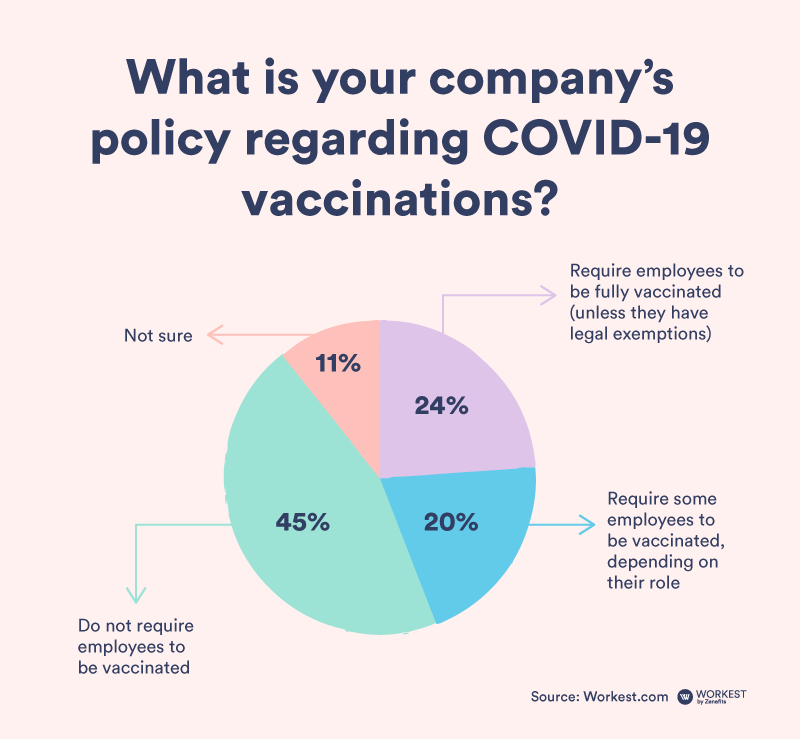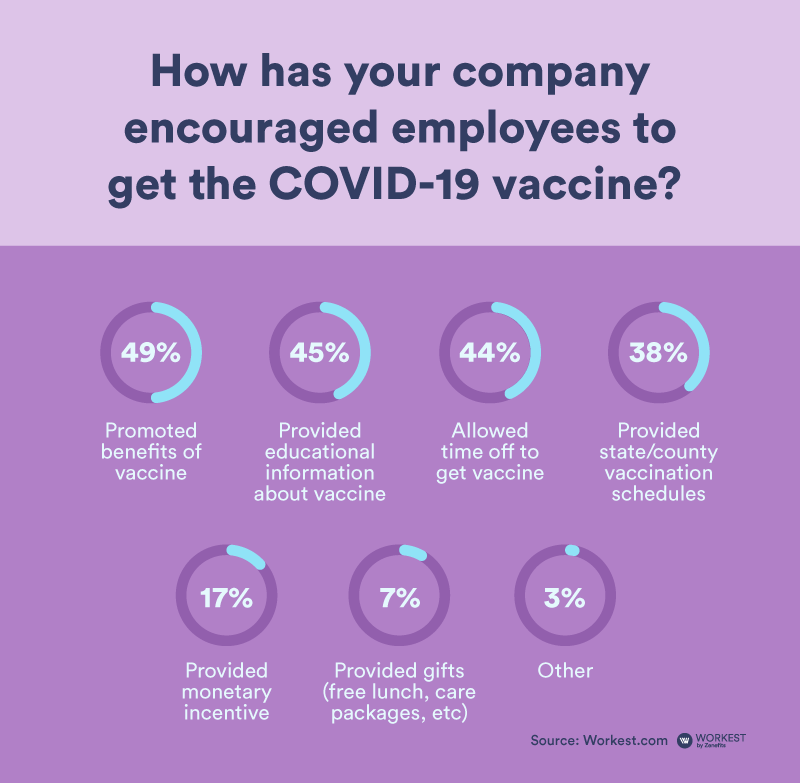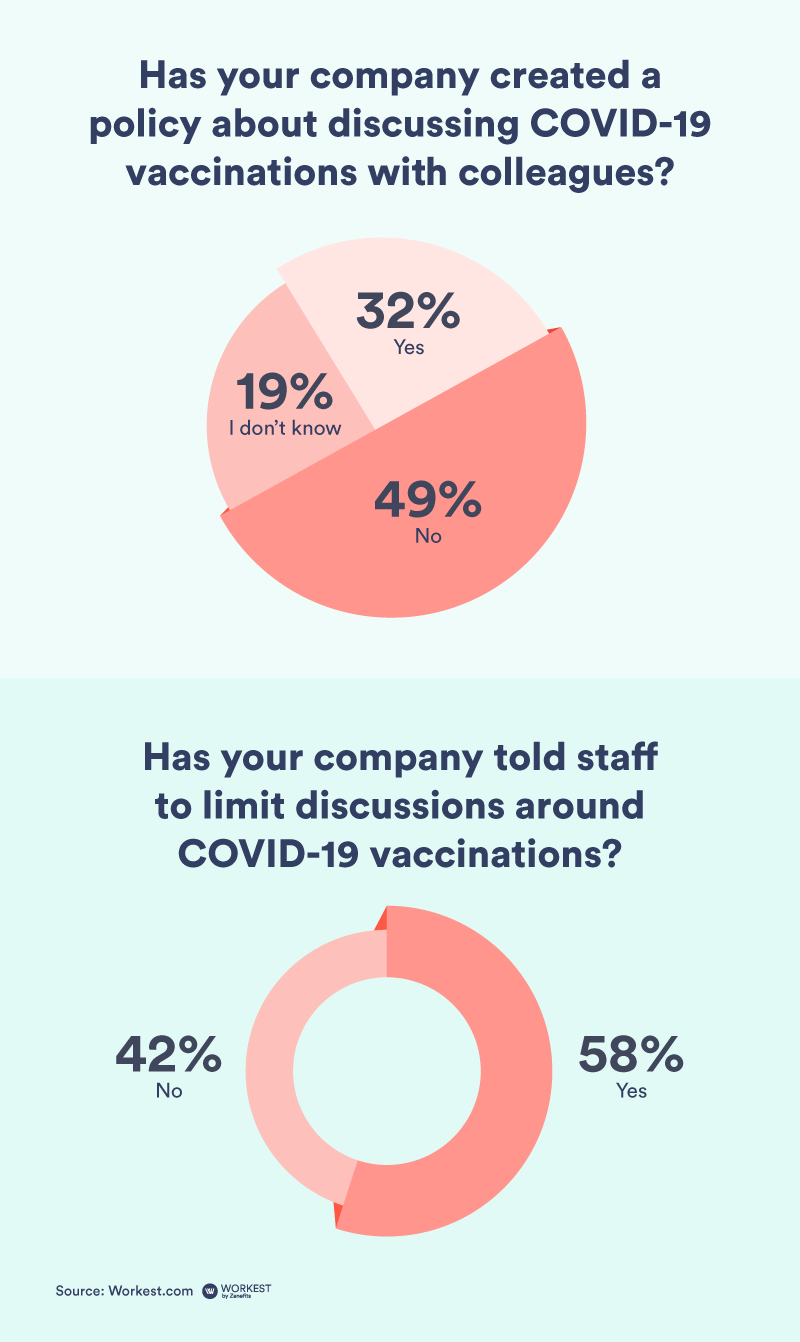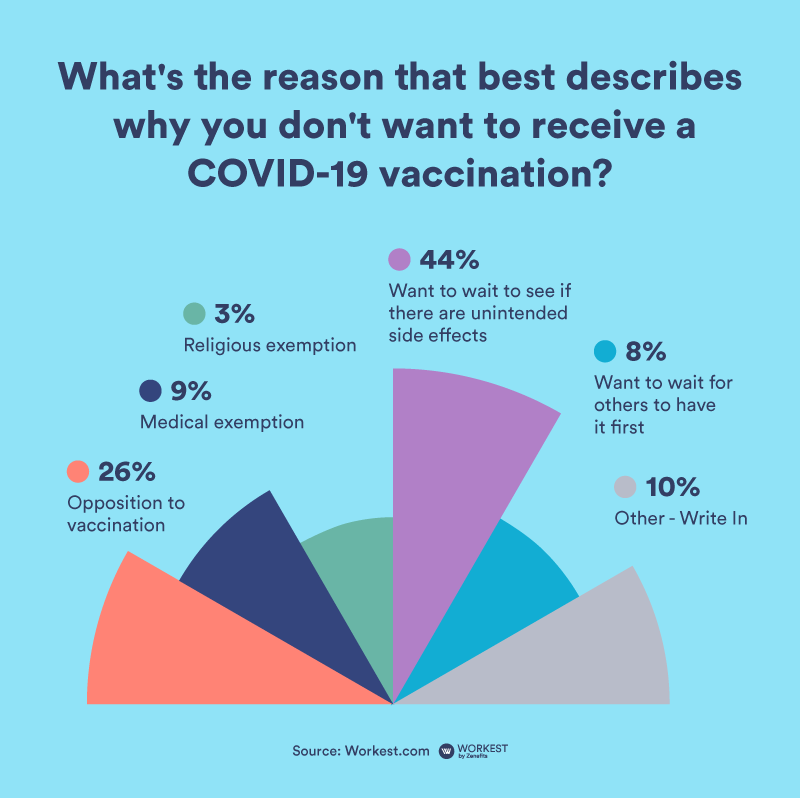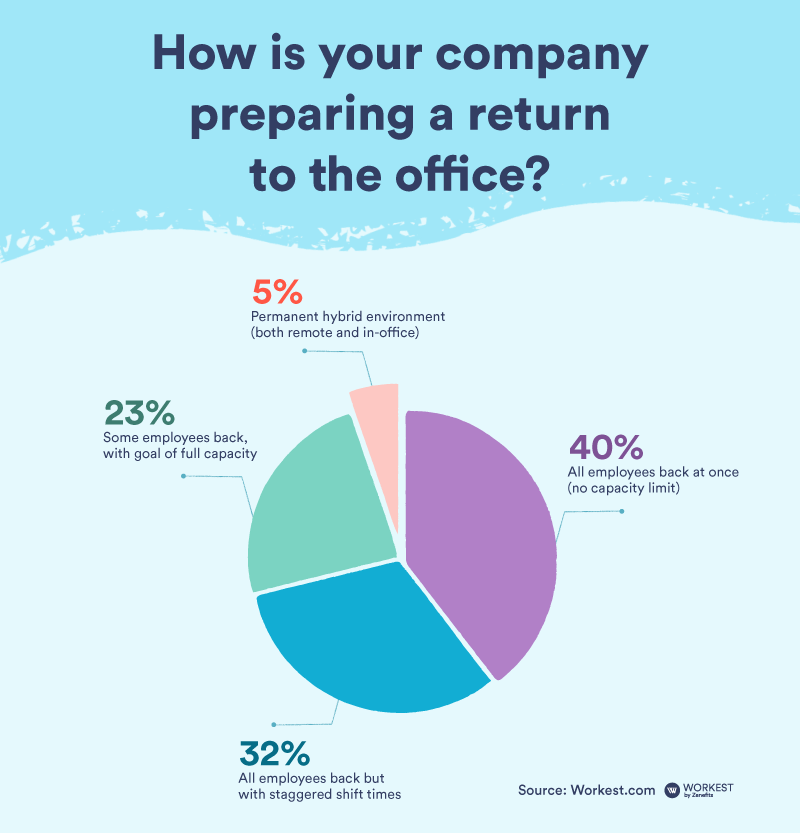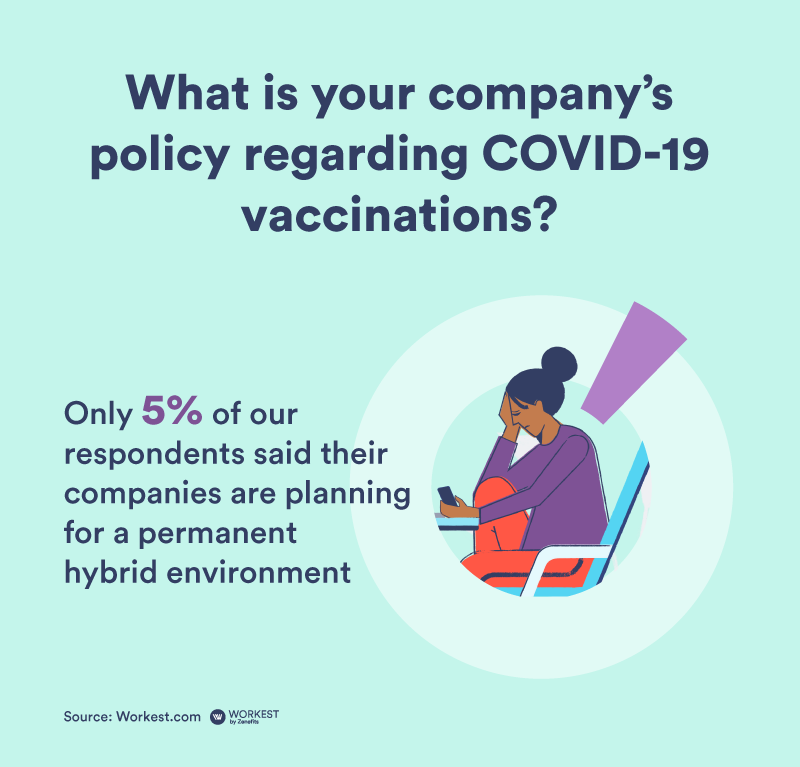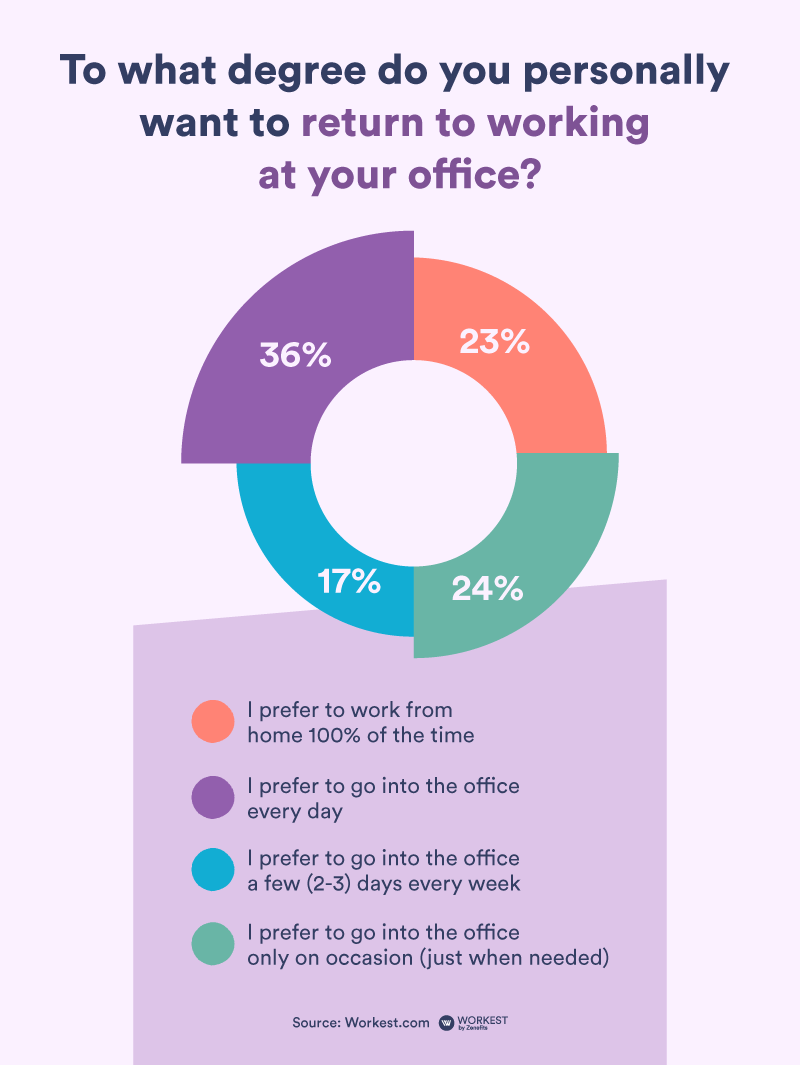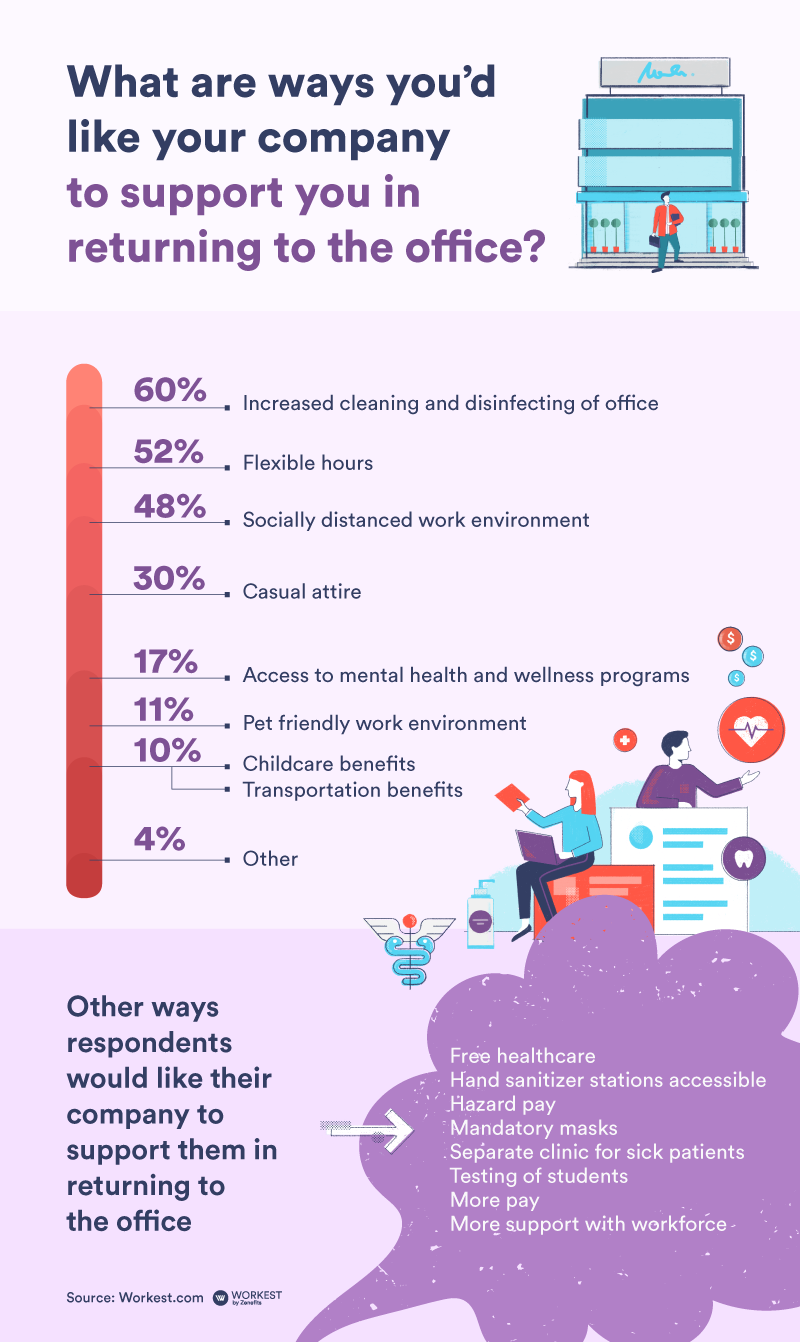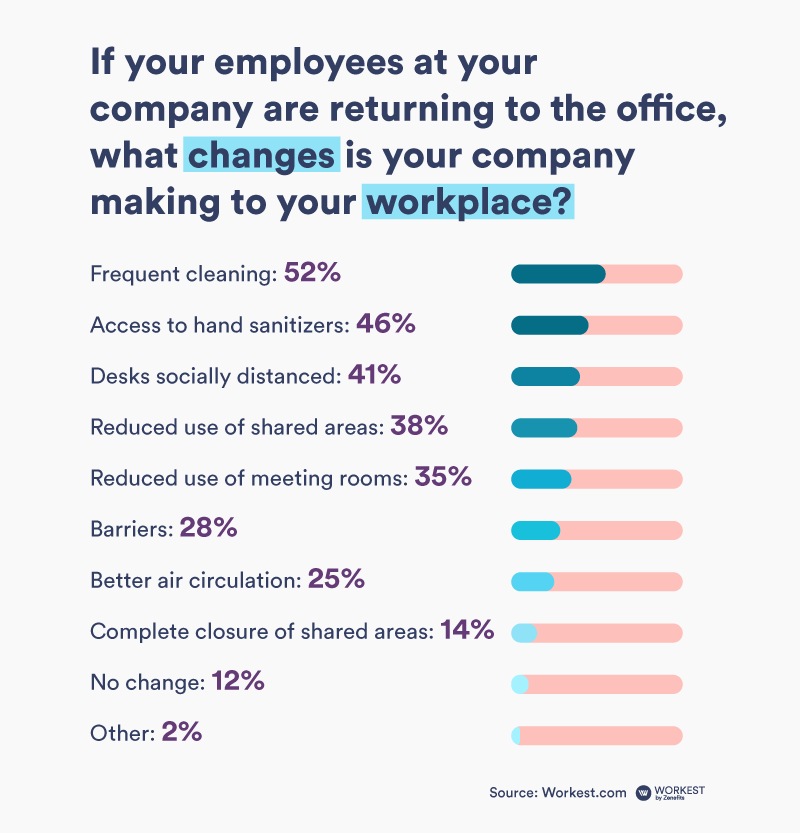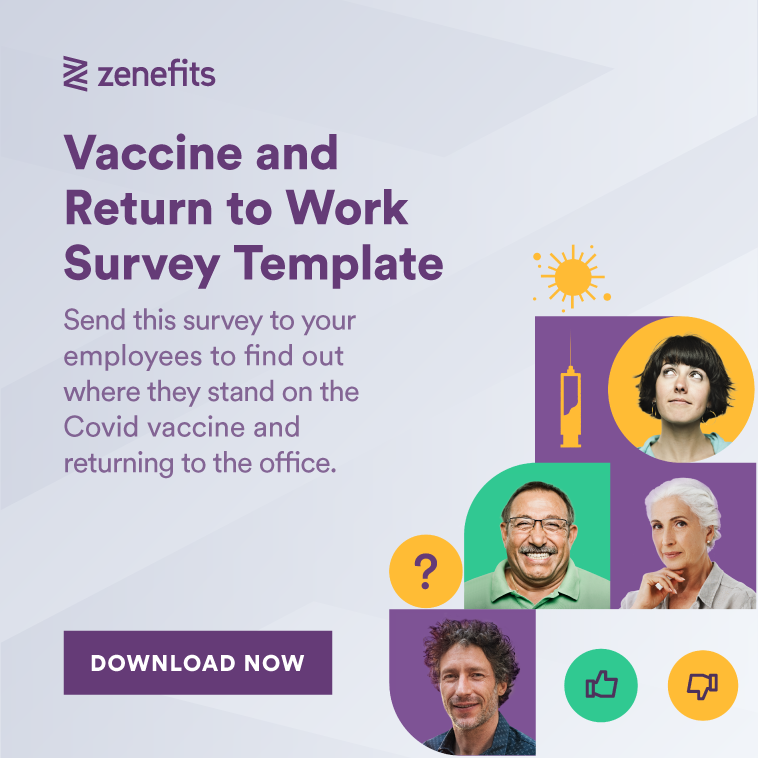64% of Unvaccinated Employees Don’t Intend on Getting a Shot, Plus Other Return to Work Insights from SMBs
To get a pulse on how returning to work and COVID-19 vaccinations are affecting small business owners and employees right now, we surveyed more than 1,000 of them about their experiences and preferences.
The coronavirus pandemic began over a year ago, and caused a global work-from-home experiment. Now, with around 87.6 million Americans fully vaccinated, many companies are ending the 100% remote work model, and are starting to have employees return to offices in some fashion.
Many major companies, like PwC and IBM, are returning employees back to work later this year, and allowing a combination of remote and office schedules depending on roles. Alternatively, General Motors announced their more remote-forward approach that allows employees to have the “flexibility to work where they can have the greatest impact on achieving our goals.”
If one thing is for certain during these uncertain times, it’s that we all don’t share uniform preferences when it comes to returning to work and COVID-19 vaccinations.
If one thing is for certain during these uncertain times, it’s that we all don’t share uniform preferences when it comes to returning to work and COVID-19 vaccinations. How does the small and medium-sized business community feel? Spoiler alert: Opinions are divided, and the results are surprising.
Workest by Zenefits surveyed more than 1,000 part- and full-time, W2 and 1099 employees, HR managers, and business owners at small or medium-sized businesses to find out.
Workplace vaccination policies
Businesses have not been able to fully reopen, and that is because Americans have not reached herd immunity (and experts think reaching herd immunity in the U.S. is unlikely).
Dr. Anthony Fauci, Chief Medical Advisor to the President, believes that 70 to 80% of the population will need to be vaccinated in order for the country to reach herd immunity. At the time this article was published, around 32% of the population was fully vaccinated.
While the country still has a ways to go to reach the 70-80% mark, many companies still aren’t mandating staff to get vaccinated. In fact, 45% of respondents said their company does not require employees to be vaccinated.
Although less than half of our participants said their companies have a vaccination requirement, the majority (61%) said their employer has encouraged staff to get the vaccine. 49% of those respondents said their employer promoted benefits of the vaccine.
According to our respondents, other ways their companies have encouraged vaccinations are:
- Provided educational information about vaccine (45%)
- Allowed time off to get vaccine (44%)
- Provided state/county vaccination schedules (38%)
- Provided monetary incentive (17%)
- Provided gifts (free lunch, care packages, etc.) (7%)
- Other (3%)
For respondents who selected “other,” here are other ways their companies encouraged vaccinations:
- “8 hours vacation pay”
- “Offered it free at work”
- “Arranged for appointments to to get vaccine”
According to our data, there are a significant number of companies who are not requiring workplace vaccinations. How does that make our respondents feel? We asked them, “How comfortable are you working in the office if employees are not required to be vaccinated?” The majority (52%) of respondents said they are “comfortable” or “very comfortable” at working in the office if employees are not required to be vaccinated.
The Majority (52%) of respondents said they are “comfortable” or “very comfortable” at working in the office if employees are not required to be vaccinated.
Not only are there companies that aren’t requiring their staff to get vaccinated — there are also ones who have created policies about discussing vaccinations with colleagues. Around a third (32%) of respondents said their company has created a policy about discussing COVID-19 vaccinations with colleagues. More than half of those participants (58%) said their company has told staff to limit discussions around COVID-19 vaccinations.
There’s also the possibility of interacting with customers who have not been vaccinated. The majority (70%) of our respondents said their role requires them to interact with customers. Among our participants who interact with customers at their jobs, 56% of them shared they are “comfortable” or “very comfortable” with interacting with customers who may or may not be vaccinated.
Many employees have — or plan to — get their vaccine shots during the workday. However, which employees get paid or unpaid time off to do so? Or which are allowed neither? When we asked our respondents, half of them responded that their company does provide paid leave for employees to get vaccinations. However, the other half responded that they do not receive PTO for vaccines, and 70% of that group does not receive unpaid leave to get vaccines, either.
President Joe Biden believes “No working American should lose a single dollar from their paycheck because they chose to fulfill their patriotic duty of getting vaccinated.” He recently announced a paid tax credit for small businesses that give employees paid time off to get their vaccine; the American Rescue Plan will reimburse companies up to $511 per day per employee for any PTO they use to get vaccinated.
Employers should note that they may be required under existing state and local paid-sick-leave laws to let employees use accrued leave to get a vaccine.
Vaccination preferences
When it comes to vaccinations, we know not everyone chooses to receive one.
We polled our respondents and found that 44% of them have not received a vaccination. Of those 44%, almost 2/3 (64%) don’t want to receive one.
We polled our respondents and found that 44% of them have not received a vaccination. Of those 44%, almost 2/3 (64%) don’t want to receive one.
Why don’t they? 44% want to want to wait to see if there are unintended side effects.
Other reasons include:
- Religious exemption (3%)
- Medical exemption (9%)
- Opposition to vaccination (26%)
- Want to wait for others to have it first (8%)
- Other (10%)
Return to work, remote work, or both?
Although the world has seen a surge in remote work due to the pandemic, many companies are planning a return to the office. Two out of every three (67%) of respondents said their company is preparing a return to the office, and 40% said their companies are planning to bring all employees back at once with no capacity limit. While many of our respondents’ companies aren’t enforcing capacity limits, the CDC has issued guidance stating that employers should take into account workplace factors such as “feasibility of social distancing in the workplace” and “ability to stagger employee shifts.”
On the flip side, 32% of participants said all employees at their companies will be back but with staggered shift times, and 24% said some employees will be back, with a goal of full capacity.
Although “hybrid workplace” seems to be a popular buzzword, only 5% of our respondents said their companies are planning for a permanent hybrid environment.
Return to work vs. remote work preferences
Working from home has a plethora of advantages — lack of commute, location independence, and for most remote workers, very relaxed attire (sweats and slippers, anyone … everyone?). However, there are many who still prefer a traditional, in-office setting. In fact, 36% of our respondents prefer to go into the office every day.
Around a quarter of our respondents (24%) prefer to go into the office on occasion (just when needed) and another quarter (23%) prefer to work from home 100% of the time. 17% prefer to go into the office 2 to 3 days a week.
Location flexibility is often touted as one of the top benefits of remote work. However, when we asked our respondents if the pandemic changed the importance of the location of where they work (working remote, hybrid), 42% said they feel no real change.
About 1 in 4 employees (26%), said having location is much more important to them now than before, and around the same number (26%) said having location flexibility is slightly more important to them now than before.
Those who have become accustomed to the partial or fully remote life may not be ready or willing to go back to the office daily. Alternatively, there are individuals who may be itching to return to their offices. We surveyed our respondents on whether they would quit their job or explore new opportunities if required to go back into their office daily. 49% said they’re “unlikely” or “very unlikely” to do so, followed by 21% who were neutral on the topic.
We surveyed our respondents on whether they would quit their job or explore new opportunities if required to go back into their office daily. 49% said they’re “unlikely” or “very unlikely” to do so.
What often comes with remote work is flexible hours, such as working outside a traditional 8-5 schedule, or getting to work on weekends if you prefer those days over the weekdays. With the increase in remote work due to the pandemic, a growing number of workers are reaping the benefits of more flexible schedules.
But how important is it to people? When we asked respondents how much the pandemic changed the importance of having a flexible work schedule, 38% said no real change, followed by 32% who said a flexible work schedule is much more important to them now than before.
Returning to the office
Employers in the new normal need to make updates to their workplaces as they prepare to bring employees back. It’s not enough to just open up offices; employees and business owners want specific support as they return.
When we asked participants for ways they’d like their company to support them in returning to the office, their top 3 choices were:
- Increased cleaning and disinfecting of office (60%)
- Flexible hours (52%)
- Socially distanced work environment (48%)
Here’s what else respondents ranked:
- Casual attire (30%)
- Access to mental health and wellness programs (17%)
- Pet friendly work environment (11%)
- Childcare benefits (10%)
- Transportation benefits (10%)
4% of respondents also shared other ways they’d like their companies to support them as they go back to their offices.
- Free healthcare
- Hand sanitizer stations accessible
- Hazard pay
- Mandatory masks
- Separate clinic for sick patients
- Testing of students
- More pay
- More support with workforce
It seems as though the pandemic has led to concrete changes for many workplaces. We asked participants what changes their companies are making as employees return to the office, and the majority (52%) said their company has incorporated frequent cleaning.
Other measures include:
- Access to hand sanitizers (46%)
- Desks socially distanced (41%)
- Reduced use of meeting rooms (35%)
- Reduced use of shared areas (32%)
- Barriers (28%)
- Better air circulation (25%)
- Complete closure of shared areas (14%)
- No change (12%)
- Other (2%)
86% of our respondents also shared that their companies are mandating staff to wear masks in the office.
86% of our respondents also shared that their companies are mandating staff to wear masks in the office. This contrasts with University of Southern California data that reveals half of adults in the United States admit they don’t wear masks when in close contact with non-household members.
Methodology and limitations
We surveyed 1,009 people via Alchemer from April 16 to 19, 2021, about returning to work and workplace COVID-19 vaccinations. The participants are part- and full-time, W2 and 1099 business owners, employees, and HR managers of small- to medium-sized businesses, defined as companies with 1 to 499 employees.
Of all the surveyed participants, 53% identified as female and 46% identified as male. Respondents are age 18 and older.
The main limitation of the study is its reliance on self-reported data. Issues with self-reported responses include, but aren’t limited to, exaggeration, selective memory, telescoping, attribution, and recency bias.

